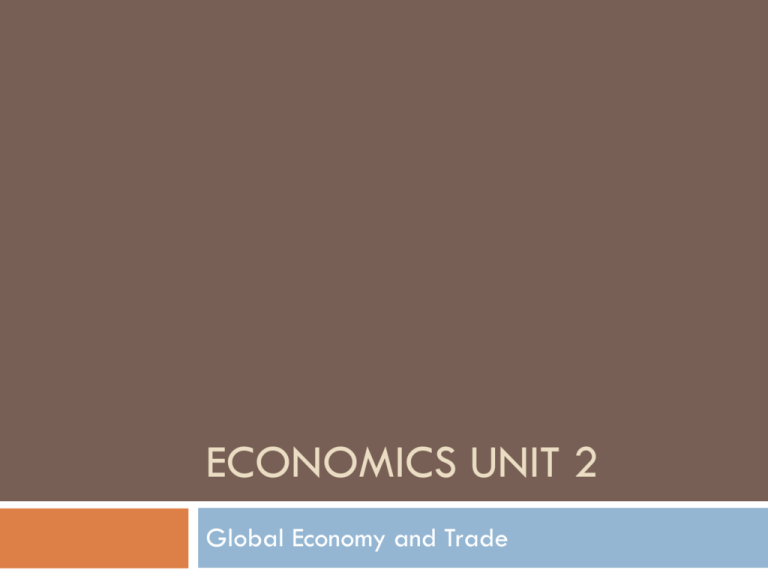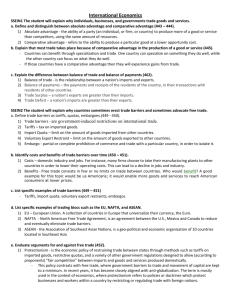Economics Unit 2 - Ms. McManamy's Class
advertisement

ECONOMICS UNIT 2 Global Economy and Trade Absolute vs. Comparative Advantage What have you traded in the past? Why did you trade? Why would the other person trade with you? Absolute vs. Comparative Advantage Using the Word Map (it has two sides), define and show Absolute Advantage and Comparative Advantage The words are defined for you in your economics textbook Trading Game Goal: Have the highest standard of living at the end Absolute and Comparative Advantage In pairs, complete this practice Raise your hand if you have any questions It has a front and a back! Global Trade If you prefer to buy American-made products, raise your hand If you prefer to buy the best and cheapest products, raise your hand Would you be willing to pay twice for the goods not produced in the US? Free Trade vs. Protectionism You will be put into groups of 3-4 Half of your group will be for free trade. The other half will be in favor of tariffs and protectionism Using the textbook and your devices, identify at least 4 arguments for your topic Free Trade vs. Protectionism Identify the other people that have your topic Get in a large group and create a master list of arguments for your topic Each side will pick a representative to argue their point of view Effects of free trade on economic activity Free trade – the free flow of goods and services between countries without any barriers or restrictions Improves overall economic welfare By allowing each country to specialize in the goods it can produce cheaply and efficiently relative to other countries, free trade arrangements enable all countries to achieve higher real incomes. Effects of trade barriers on economic activity: Trade barriers – anything that prevents the free flow of goods and services coming into a country Tariffs and quotas raise the prices of imported goods. Subsidies lower the price of exported goods. Trade barriers guide consumers toward domestically produced goods. Trade barriers raise prices for consumers. By shielding industries from some foreign competition, trade barriers may slow improvements or innovations to lower costs. International Free-Trade Agreements International free-trade agreements – an international free-trade agreement results from cooperation between at least two countries to reduce trade barriers and tariffs and to trade with each other. Free-trade agreements include: NAFTA (North American Free Trade Agreement) (1994) – U.S., Mexico, and Canada agreed to phase out all tariffs on merchandise trade and to reduce restrictions on trade in services and foreign investment. EU (European Union) OPEC (Organization of Petroleum Exporting Companies Benefits and Costs Benefits – promote greater trade among the parties, broadens the market, increases competition and specialization Costs – individual countries lose some autonomy in that they have to go along with policies of the agreement, whether individually advantageous or not. By excluding certain countries, these agreements may shift the composition of trade from low-cost countries that are not party to the agreement to high-cost countries that are. Some argue that such agreements serve the interests of multinational corporations and not workers. Balance of Trade Balance of trade – nations seek to maintain a balance of trade with values of imports equal to exports. By balancing trade, a nation can protect the value of its currency on the international market. If a trade imbalance continues, with one country importing more than it is exporting, the value of its currency falls. Exchange rates – in international finance, foreign currency is called foreign exchange, and the currency is bought and sold on a foreign exchange market. The rate of exchange is based on the amount of foreign currency in circulation. If the American dollar appreciates against a foreign currency, the dollar gains purchasing power, making foreign goods less expensive at home and American goods more expensive overseas. American imports would increase. Balance of Trade If the American dollar depreciates against a foreign currency, the dollar loses purchasing power, making foreign goods more expensive at home and American goods less expensive overseas. American exports would increase. Examples Ex: In the 1980s, the United States imported considerably more than it exported, and the foreign exchange market was glutted with dollars. As the value of the dollar fell, the prices of imports increased and consumers paid more for the goods. The imbalance can be corrected by limiting imports or increasing the number and/or quality of exports. Both of these actions affect trading partners which may retaliate by raising tariffs. Maintaining a balance of trade requires international cooperation and fair trade. Ex: If the United States seeks to import Volvos from Sweden, the importer pays for the automobile with U.S. dollars. If the car costs 35,000 kroner (Swedish currency) but the U.S. dollar is worth six Swedish kroner, the Volvo costs approximately $5,100. As more U.S. currency enters the Swedish market, and as the demand for Volvos increases, the Swedish kroner become more valuable when compared to the U.S. dollar. Thus the foreign exchange rate changes from $1.00 = 6 K to $1.00 = 4.5 K. The car now costs an American importer approximately $7,000. Deal Sweeteners Read the article and answer the questions along with it Protectionism vs. Free Trade Create a table showing arguments for protectionism and free trade. Using this information, write an editorial for the newspaper supporting free trade or protectionism. Due at the end of the period.







